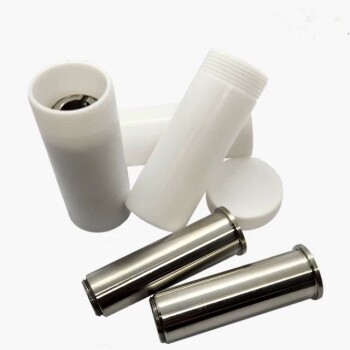Wiped film molecular distillation (WFMD) is a specialized distillation technique used to separate and purify heat-sensitive materials, such as oils, terpenes, and cannabinoids, under high vacuum and low temperatures. The process involves creating a thin, turbulent film of the feedstock on a heated surface using rotating wipers, which enhances heat transfer and separation efficiency. Volatile components evaporate and are condensed on a cooler surface, while heavier residues are collected separately. WFMD is highly efficient, minimizes thermal degradation, and is suitable for both batch and continuous operations. It is widely used in industries like pharmaceuticals, essential oils, and cannabis extraction.
Key Points Explained:

-
Core Principle of Wiped Film Molecular Distillation:
- WFMD relies on creating a thin, uniform film of the feedstock on a heated surface using rotating wipers (often made of PTFE).
- This thin film maximizes surface area, ensuring efficient heat transfer and rapid evaporation of volatile components.
- The process operates under high vacuum, reducing the boiling points of components and minimizing thermal degradation.
-
Key Components of the System:
- Evaporator: A vertical cylindrical chamber heated from the outer wall. The feedstock is distributed on the inner wall.
- Wiper System: Rotating wipers or rollers spread the feedstock into a thin film and ensure continuous mixing, enhancing mass transfer.
- Condenser: Located centrally or externally, it cools and condenses the vaporized components into distillate.
- Receiving Vessels: Separate containers collect the distillate (volatile components) and residue (heavier fractions).
-
Process Workflow:
- Feed Introduction: Crude oil or feedstock is pumped into the evaporator using an automatic dosing pump.
- Film Formation: The wipers create a thin, turbulent film on the heated evaporator wall.
- Evaporation: Heat causes the volatile components to vaporize, while heavier residues flow downward.
- Condensation: Vapors are condensed on the cooler condenser surface.
- Collection: Distillate and residue are collected in separate vessels.
-
Advantages of Wiped Film Molecular Distillation:
- Efficient Separation: The thin film and turbulent flow enhance separation efficiency.
- Low Thermal Stress: High vacuum and short exposure to heat minimize degradation of heat-sensitive compounds.
- Scalability: Suitable for both small-scale batch and large-scale continuous operations.
- Versatility: Can handle a wide range of materials, including essential oils, cannabinoids, and pharmaceuticals.
-
Applications:
- Cannabis Industry: Used to separate and purify cannabinoids (e.g., CBD, THC) and terpenes.
- Essential Oils: Extracts and purifies volatile compounds from plant materials.
- Pharmaceuticals: Purifies heat-sensitive active pharmaceutical ingredients (APIs).
- Food Industry: Processes oils and fats without compromising quality.
-
Critical Process Parameters:
- Temperature: Must be optimized to ensure efficient evaporation without thermal degradation.
- Vacuum Level: High vacuum reduces boiling points and protects heat-sensitive materials.
- Feed Rate: Controlled to maintain a consistent thin film and prevent overflow.
- Wiper Speed: Ensures proper mixing and film thickness.
-
Comparison to Other Distillation Methods:
- Short-Path Distillation: Similar to WFMD but typically used for smaller-scale operations with shorter vapor paths.
- Traditional Distillation: Less efficient for heat-sensitive materials due to longer exposure to high temperatures.
- Advantages of WFMD: Higher efficiency, lower thermal stress, and better scalability compared to traditional methods.
-
Considerations for Equipment Purchasers:
- Material Compatibility: Ensure wipers and evaporator surfaces are compatible with the feedstock (e.g., PTFE for chemical resistance).
- Scalability: Choose a system that can handle current and future production needs.
- Ease of Cleaning: Look for designs that simplify cleaning and maintenance.
- Energy Efficiency: Evaluate heating and cooling systems for optimal energy use.
- Automation: Consider systems with automated controls for temperature, vacuum, and feed rate.
By understanding these key points, equipment and consumable purchasers can make informed decisions about implementing wiped film molecular distillation in their operations, ensuring optimal performance and product quality.
Summary Table:
| Aspect | Details |
|---|---|
| Core Principle | Thin, turbulent film creation using rotating wipers for efficient separation. |
| Key Components | Evaporator, wiper system, condenser, and receiving vessels. |
| Process Workflow | Feed introduction → film formation → evaporation → condensation → collection. |
| Advantages | High efficiency, low thermal stress, scalability, and versatility. |
| Applications | Cannabis, essential oils, pharmaceuticals, and food industry. |
| Critical Parameters | Temperature, vacuum level, feed rate, and wiper speed. |
| Comparison to Others | More efficient and scalable than traditional distillation methods. |
| Purchasing Considerations | Material compatibility, scalability, ease of cleaning, and automation. |
Ready to optimize your material purification process? Contact us today to learn more about wiped film molecular distillation!












